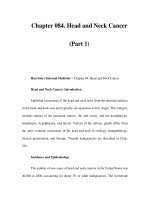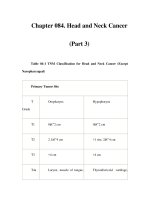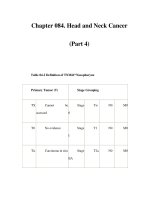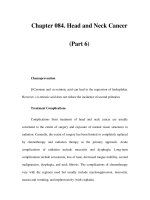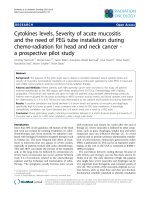revisiting induction chemotherapy before radiotherapy for head and neck cancer part ii nasopharyngeal carcinoma
Bạn đang xem bản rút gọn của tài liệu. Xem và tải ngay bản đầy đủ của tài liệu tại đây (1.61 MB, 4 trang )
REVIEW
EDITORIAL
For reprint orders, please contact:
Revisiting induction chemotherapy
before radiotherapy for head and
neck cancer, part II: nasopharyngeal
carcinoma
“Delaying concurrent chemoradiation for the purposes of initiating
induction chemotherapy should generally be reserved for situations of
practical or logistical barriers to chemoradiation or as a defined
operational procedure, preferably as part of a clinical trial.”
Christopher H Chapman1, Upendra Parvathaneni2 & Sue S Yom*,1
First draft submitted: 11 December 2016; Accepted for publication: 6 January 2017;
Published online: 7 February 2017
Background of induction
chemotherapy for nasopharyngeal
carcinoma
We have separately outlined the history
and evidence basis of induction chemotherapy for non-nasopharyngeal head and
neck carcinomas, describing results for the
anatomic subsites tested in western countries: oral cavity, oropharynx, larynx and
hypopharynx [1] . On the other hand, nasopharyngeal carcinoma, which is rare in
Europe and North America, is much more
common in southeast Asia, the Middle
East and among the Inuit populations.
The nonkeratinizing and undifferentiated
endemic types are highly associated with
Epstein–Barr virus (EBV). The clinical
behavior of endemic nasopharyngeal carcinoma is also distinct, affecting younger
patients and having a high propensity to
nodal and distant metastasis [2] . For these
reasons, nasopharyngeal carcinoma has
historically been addressed in separate
clinical trials and a different staging system
has been developed. Yet despite these differences, the history of induction chemotherapy in nasopharyngeal carcinoma has
paralleled that in other sites, with generations of trials investigating cisplatin/5FU
(PF), the addition of taxanes (TPF), and
the use of agents targeting the EGFR.
The establishment of adjuvant
chemotherapy
In 1998, the North American Intergroup
0099 trial showed that concurrent
cisplatin-radiotherapy prolonged survival compared with radiation alone [3] ,
a conclusion that was confirmed by a
subsequent trial in the endemic population [4] . Importantly, both of these trials
also included an extended course of adjuvant cisplatin/5FU. Compliance with the
adjuvant chemotherapy phase was low
in both trials, leaving some uncertainty
about its relative importance. Similar to
the MACH-NC analysis in other sites, the
MAC-NPC meta-analysis examined the
effect of timing of chemotherapy on results
for nasopharyngeal carcinoma [5,6] . This
study only identified an overall survival
benefit for concurrent chemotherapy versus radiation alone, although locoregional
and distant control were both improved
KEYWORDS
• antineoplastic agents
• antineoplastic combined
chemotherapy protocols cell
• carcinoma • combined modality
therapy • induction therapy
• molecular targeted therapy
• nasopharyngeal neoplasms
• neoadjuvant therapy • sequential
therapy • squamous • treatment
outcomes
“...nasopharyngeal carcinoma has
historically been addressed in
separate clinical trials and a
different staging system has been
developed.”
Department of Radiation Oncology, University of California San Francisco, San Francisco, CA, USA
Department of Radiation Oncology, University of Washington, WA, USA
*Author for correspondence: Tel.: +1 415 353 9893; Fax: +1 415 353 9883;
1
2
10.2217/fon-2016-0544 © Sue S Yom
Future Oncol. (2017) 13(7), 581–584
part of
ISSN 1479-6694
581
Editorial Chapman, Parvathaneni & Yom
“...the addition of adjuvant
chemotherapy to
concurrent
chemoradiotherapy for
nasopharyngeal carcinoma
has persisted as a part of
the standard of
care ... although the
evidence for its use has
been mixed.”
582
with induction chemotherapy versus radiation
alone.
The updated meta-analysis in 2015 attempted
to compare concurrent plus adjuvant chemotherapy to concurrent chemotherapy alone. A
significant overall survival benefit was seen for
concurrent chemotherapy (+5.3% at 5 years, as
compared with radiation alone), and a greater
magnitude of benefit was seen for concurrent
plus adjuvant (+12.4% at 5 years), but there was
no statistically significant difference between the
two groups. Although there were questions about
the heterogeneity of the studies included in the
meta-analysis, these results at least suggested
that adding more chemotherapy could potentially improve survival outcomes. In contrast to
other head and neck sites, because of the relatively low rates of locoregional failure and high
rates of distant failure seen in nasopharyngeal
cancer, this hypothesis appeared to be biologically plausible. However, there was no comparison of concurrent with adjuvant versus concurrent with induction in this meta-analysis, so the
potential advantage of induction as opposed to
the standard adjuvant phase remained unclear.
In the Intergroup 0099 study, only 55% of
patients were able to complete adjuvant chemotherapy. However, a post-hoc analysis of similar
studies found an association between completion of adjuvant chemotherapy and freedom
from distant and locoregional recurrence [7] .
It was hypothesized that switching from adjuvant to induction chemotherapy would improve
outcomes by allowing for more completion of
chemotherapy before radiation, at a time when
cumulative toxicity would be lower. This was
directly tested by NPC-0501, a multiarm study
in which patients were randomized to either
adjuvant or induction chemotherapy (using
either cisplatin/5FU or cisplatin/capecitabine) in
addition to concurrent cisplatin-radiotherapy [8] .
This study resulted in 88% of induction patients
completing all chemotherapy, versus only
64% of adjuvant-assigned patients. However,
although a multivariate analysis found improved
progression-free and overall survival associated
with the induction arms, the unadjusted comparisons were nonsignificant and findings were
considered inconclusive in the end.
A new meta-analysis in publication has further examined chemotherapy sequencing, and
like MAC-NPC finds the greatest survival
advantage for concurrent plus adjuvant, but not
significantly different than concurrent alone [9] .
Future Oncol. (2017) 13(7)
Induction plus concurrent was superior to radiation alone, and not statistically different than
concurrent alone or adjuvant plus concurrent
for overall survival. Intriguingly, induction plus
concurrent had the greatest benefit for distant
control, suggesting a path for future investigation
in subgroups at high metastatic risk.
Taxane-based induction for
nasopharyngeal carcinoma
As in other sites, the arrival of taxanes revived
interest in induction for nasopharyngeal carcinoma, especially after a randomized Phase II
trial found a 26% absolute improvement in
3-year overall survival with induction TPF versus concurrent cisplatin radiotherapy alone [10] .
However, results from further studies with taxanes were mixed. A Phase II study from Greece
found no difference in overall response rate or
other end points when adding cisplatin/epirubicin/paclitaxel induction to concurrent cisplatin radiotherapy [11] . Another Phase II/III
study from Singapore found no benefit from the
addition of gemcitabine/carboplatin/paclitaxel
induction [12] . Yet, a recently published Phase III
trial testing the addition of TPF induction did
find significant improvements in overall survival
and distant-failure-free survival in the induction
arm [13] . The reasons for the discrepancies in these
various trial results are unclear, but may result
from differences in patient populations, statistical power, and treatment regimens. Another area
of uncertainty is the lack of stratification by circulating EBV DNA levels, a prognostic factor in
nasopharyngeal carcinoma [14] . In the aggregate,
these trials suggest that induction TPF in particular could improve outcomes compared with
chemoradiotherapy alone, although the comparison of induction versus adjuvant chemotherapy
remains unclear. In contrast to other head and
neck sites, there seems to be more possibility that
the additional toxicity from induction chemotherapy might be balanced by improvements in
survival in nasopharyngeal carcinoma.
Induction to select for reduced-intensity
radiation-based treatment
Like in other sites, EGFR-targeted agents have
been investigated as a way of lowering toxicity
while accruing the benefits of additional therapy.
A recently presented multi-institutional study
treated patients with locally advanced nasopharyngeal carcinoma with induction TPF, and
then randomized the patients to either concurrent
future science group
Induction chemotherapy for head and neck cancer, part II
cisplatin or the EGFR-antibody nimotuzumab
with radiation (NCT02012062) [15] . The primary
end point of the study was toxicity. Treatmentrelated cytopenias, anorexia, nausea and fatigue
were all less frequent with nimotuzumab, and
the completion rate was 97& versus 40% for
cisplatin. Like the French TREMPLIN trial
for laryngeal carcinoma and the Spanish Head
and Neck Cancer Group 2007-01 trial for other
sites, no differences were seen in rates of overall or
progression-free survival. If these results are validated for survival end points, presumably patients
could safely receive a more tolerable EGFR-based
concurrent regimen following induction.
An alternative strategy being investigated
by the multi-institutional NRG-HN001 study
(NCT02135042) uses the postchemoradiation plasma EBV DNA level as a biomarker
of response, which may be more predictive
than the pretreatment level [16] . After concurrent chemoradiation, this trial assigns patients
to adjuvant chemotherapy by their risk level
as determined by detectability of EBV DNA,
with the twin goals of shifting the intensity (and
toxicity) of additional treatment to those who
might benefit most from it, while testing the
safety of eliminating chemotherapy for those
in whom EBV DNA becomes undetectable.
Patients who have detectable EBV DNA are
randomized to cisplatin/5FU or an experimental
regimen of gemcitabine/paclitaxel. Patients who
have no detectable EBV DNA are randomized
to the current standard of care, consisting of
adjuvant cisplatin/5FU, or no further treatment.
The EBV DNA assay used in this study was
harmonized among several participating test
sites so that the results are consistent among
pa rticipating centers [17] .
Conclusion
In summary, the addition of adjuvant chemotherapy to concurrent chemoradiotherapy for
References
1
2
Chapman CH, Parvathaneni U, Yom SS.
Revisiting induction chemotherapy before
radiotherapy for head and neck cancer, part I:
carcinoma of non-nasopharyngeal sites.
Future Oncol. 13(6), 469–475 (2017).
Altun M, Fandi A, Dupuis O, Cvitkovic E,
Krajina Z, Eschwege F. Undifferentiated
nasopharyngeal cancer (UCNT): current
diagnostic and therapeutic aspects. Int. J.
future science group
nasopharyngeal carcinoma has persisted as a
part of the standard of care since its use in the
original Intergroup 0099 protocol, although
the evidence for its use has been mixed. While
additional chemotherapy generally appears to
be of value in the treatment of this disease, the
optimal timing, agents and population are still
to be determined. It is not clear whether induction chemotherapy with newer regimens such
as TPF may ultimately be superior to adjuvant
chemotherapy, and the introduction of EGFRtargeted agents has created promising new combinations. However, the data from randomized
trials are still maturing. At present, like in other
head and neck sites, the cornerstone of therapy
is concurrent chemoradiation. Delaying concurrent chemoradiation for the purposes of initiating induction chemotherapy should generally be
reserved for situations of practical or logistical
barriers to chemoradiation or as a defined operational procedure, preferably as part of a clinical
trial. Risk stratification with potentially predictive molecular markers such as circulating EBV
DNA may further help select patients for the
most appropriate treatment.
Financial & competing interests disclosure
SS Yom received a research grant from Genentech, honorarium from Astra-Zeneca, and royalty from UpToDate.
The authors have no other relevant affiliations or financial
involvement with any organization or entity with a financial interest in or financial conflict with the subject matter
or materials discussed in the manuscript apart from those
disclosed.
No writing assistance was utilized in the production of
this manuscript.
Open access
This work is licensed under the Creative Commons
Attribution-NonCommercial 4.0 Unported License. To
view a copy of this license, visit />licenses/by-nc-nd/4.0/
Radiat. Oncol. Biol. Phys. 32(3), 859–877
(1995).
3
4
Editorial
Al-Sarraf M, LeBlanc M, Giri PG et al.
Chemoradiotherapy versus radiotherapy in
patients with advanced nasopharyngeal
cancer: Phase III randomized Intergroup
study 0099. J Clin Oncol. 16(4), 1310–1317
(1998).
Wee J, Tan EH, Tai BC et al. Randomized
trial of radiotherapy versus concurrent
chemoradiotherapy followed by adjuvant
chemotherapy in patients with American
Joint Committee on Cancer/International
Union against cancer stage III and IV
nasopharyngeal cancer of the endemic
variety. J. Clin. Oncol. 23(27), 6730–6738
(2005).
5
Baujat B, Audry H, Bourhis J et al.
Chemotherapy in locally advanced
nasopharyngeal carcinoma: an individual
patient data meta-analysis of eight
www.futuremedicine.com
583
Editorial Chapman, Parvathaneni & Yom
randomized trials and 1753 patients. Int. J.
Radiat. Oncol. Biol. Phys. 64(1), 47–56
(2006).
6
7
8
9
584
Blanchard P, Lee A, Marguet S et al.
Chemotherapy and radiotherapy in
nasopharyngeal carcinoma: an update of the
MAC-NPC meta-analysis. Lancet Oncol.
16(6), 645–655 (2015).
Lee AWM, Tung SY, Ngan RKC et al. Factors
contributing to the efficacy of concurrentadjuvant chemotherapy for locoregionally
advanced nasopharyngeal carcinoma:
combined analyses of NPC-9901 and
NPC-9902 Trials. Eur. J. Cancer 47(5),
656–666 (2011).
Lee AWM, Ngan RKC, Tung SY et al.
Preliminary results of trial NPC-0501
evaluating the therapeutic gain by changing
from concurrent-adjuvant to inductionconcurrent chemoradiotherapy, changing
from fluorouracil to capecitabine, and
changing from conventional to accelerated
radiotherapy fractionation in patients with
locoregionally advanced nasopharyngeal
carcinoma. Cancer 121(8), 1328–1338 (2015).
Ribassin-Majed L, Marguet S, Lee AW et al.
What is the best treatment of locally advanced
nasopharyngeal carcinoma? An individual
patient data network meta-analysis. J. Clin.
Oncol. 5, JCO2016674119 (2016).
10 Hui EP, Ma BB, Leung SF et al. Randomized
Phase II trial of concurrent cisplatinradiotherapy with or without neoadjuvant
docetaxel and cisplatin in advanced
nasopharyngeal carcinoma. J. Clin. Oncol.
27(2), 242–249 (2009).
11 Fountzilas G, Ciuleanu E, Bobos M et al.
Induction chemotherapy followed by
concomitant radiotherapy and weekly
cisplatin versus the same concomitant
chemoradiotherapy in patients with
nasopharyngeal carcinoma: a randomized
Phase II study conducted by the Hellenic
Cooperative Oncology Group (HeCOG) with
biomarker evaluation. Ann. Oncol. 23(2),
427–435 (2012).
12 Tan T, Lim WT, Fong K-W et al. Concurrent
chemo-radiation with or without induction
gemcitabine, Carboplatin, and Paclitaxel: a
randomized, Phase 2/3 trial in locally advanced
nasopharyngeal carcinoma. Int. J. Radiat.
Oncol. Biol. Phys. 91(5), 952–960 (2015).
13 Sun Y, Li W-F, Chen N-Y et al. Induction
chemotherapy plus concurrent
Future Oncol. (2017) 13(7)
chemoradiotherapy versus concurrent
chemoradiotherapy alone in locoregionally
advanced nasopharyngeal carcinoma: a
Phase 3, multicentre, randomised controlled
trial. Lancet Oncol. 17(11), 1509–1520
(2016).
14 Lo YM, Chan AT, Chan LY et al. Molecular
prognostication of nasopharyngeal carcinoma
by quantitative analysis of circulating EpsteinBarr virus DNA. Cancer Res. 60(24),
6878–6881 (2000).
15 Kong L, Lin Q, Hu C et al. Radiation plus
concurrent nimotuzumab versus CDDP in
locally advanced nasopharyngeal cancer:
results of a Phase III randomised trial. J. Clin.
Oncol. (34), abst 6002 (2016).
16 Lin J-C, Wang W-Y, Chen KY et al.
Quantification of plasma Epstein–Barr virus
DNA in patients with advanced
nasopharyngeal carcinoma. N. Engl. J. Med.
350(24), 2461–2470 (2004).
17 Le QT, Zhang Q, Cao H et al. An
international collaboration to harmonize the
quantitative plasma Epstein–Barr virus DNA
assay for future biomarker-guided trials in
nasopharyngeal carcinoma. Clin. Cancer
Res. 19(8), 2208–2215 (2013).
future science group

